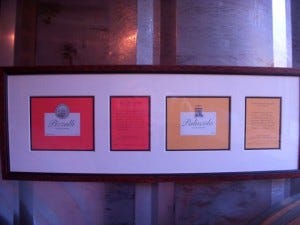Gentle Dreamer, Part Two
When our gentle hero from Part One, Cosimo, began to amass an estimable collection of wine—his own, plus some of the top labels and vintages in the world—it became clear that he needed somewhere to put them. The bespoke cellars that adorn the West's redundant crop of McMansions run into the "mid five figures." (Can you can tell I've been near Hollywood for a little too long?) Cosimo, understandably, was nonplussed at the high cost. But the fact remains brutally true that investment in—and the creation of—good wines will be wasted if the liquid gold isn't stored safely at an appropriate temperature and humidity.
When a local workman suggested the purchase of an old refrigerated metal shipping container, the kind that cranes lift on and off of ships, Cosimo initially shrugged it off as impossible, not to mention severely lacking in aesthetic value. (After all, this is a man who places great value on beauty.) Then, he heard the price: $2,000., for a ten-year-old container, certified by the USDA for food transport. Suddenly, Cosimo started thinking seriously about the possibilities, and it wasn't long before he was scrambling to finish pouring the concrete pad that is now home to the very large metal box that now houses the Pizzulli wine collection.
"First, I ripped out the old 3-phase air-conditioning compressor, which was basically useless," he says. "Then, I cut a hole in the rear wall of the container and installed a brand new Breeze-Air." (Cost: about $1500.) Now his cellar was secure, and boasted a state-of-the-art temperature control, but although he could happily store his smaller barrels inside, there was still no support system for the bottles. He checked with a wine rack retailer, but found the cost, again, high. Not to mention the fact that the racks would have to be modified to fit the container efficiently, adding further cost to the project.

Cosimo asked his uncle, a retired carpenter, to give him a hand building the racks. The two men spent six hours a day for four days, cutting, stapling, and erecting the sections. Three more days were spent setting up the racks and fitting them carefully together like a puzzle. "The beautiful thing about this is that anyone could do it—all you need is a level pad and power," says Cosimo.
"Very Thomas Jefferson," I say. And despite the utilitarian look, aesthetically pleasing, too. In this case, form follows not terribly far behind function. Cosimo added a tall wood table for tastings, and framed a few of his early labels. This man-cave is literally full of joy, both the liquid kind and the emotion. "You could clad the outside with wood, or bury it in the side of a hill," says Cosimo. But he's finished with the cellar, for now—eager to get back to his true passion: making great wines.

The Pizzulli wines aren't available to the public except at a very few Los Angeles restaurants, such as Drago, Baldi, and Grill on the Alley. Only fifty cases of that luscious Dolcetto were made, because the grower up in the Central Coast is losing interest in the varietal.
One taste of the Pizzulli Dolcetto should rekindle it.



